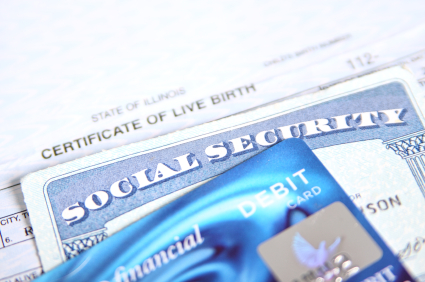 Implementing a name change after marriage involves quite a few aspects ranging from whether or not you should do so to exactly what is involved in the process. Due to the tedious nature of this task, it is important to consider each of the following facets first.
Implementing a name change after marriage involves quite a few aspects ranging from whether or not you should do so to exactly what is involved in the process. Due to the tedious nature of this task, it is important to consider each of the following facets first.
Options for a Name Change After Marriage
The most common options involving a name change after marriage are:
1. Take the traditional route and use your husband’s name in place of your maiden name. This is the most commonly accepted course of action in the United States.
2. Replace a middle name with the maiden name and select the husband’s name.
3. Hyphenate using your name first and then your husband’s name, or vice versa. Difficulties arise for your children as they mature and marry and are faced with joining a hyphenated name with the name of their spouse.
4. Keep your middle name and your maiden name and simply add your husband’s last name to the end of your names.
5. Both of you can choose to create a new name that you share.
6. Continue to use your maiden name professionally while using his name as your social name; however, this can lead to confusion with your personal affairs.
7. Keep your name and your husband keeps his. This can lead to confusion by others as to whether or not the two of you are married.
8. Keep your name and he takes yours.
You must carry through with changing your name on all documentation for all of these options except the last two.
Reasons to Change Your Last Name
Deciding to change your name after marriage can involve psychological, emotional, and practical reasons, including:
1. Tradition and social mores – This is the way that it has been done for centuries. You avoid the unpleasantness of other people’s disrespectful comments as well as the likelihood that many people will still refer to you as Mrs. “husband’s name.â€
2. Cultural beliefs – Wanting to keep your husband’s heritage and ancestral background.
3. Practical – Your children have the same name as their father.
4. Family lineage and pride – Keeping the family together with name recognition of extended family members.
5. Romantic notions – Proving your commitment to your spouse.
Reasons Not to Change Your Last Name
Whether or not to change your name after marriage has become more of a personal decision over the years. Several reasons exist that may dissuade you from choosing to do so:
1. Inconvenience – Changing your name after getting married brings with it a long list of agencies and businesses that must be notified in writing with the proper documentation that your name has changed.
2. Professional consideration – If a woman has established a career for herself using her maiden name, she may lose this recognition and momentum.
3. Cultural and family significance – If you marry someone from another cultural background or a less significant lineage, your pride in your ethnic background may prevent you from assuming his name as your own. If no males holding the family name remain, a woman may prefer to retain her maiden name in order to extend the family line.
4. Aesthetics – The sound of a woman’s first name when combined with a newly acquired married name may sound awful.
5. Sense of independence – Societal implications in the name change as a woman marries is sometimes seen as a transfer of ownership from the father to the husband.
6. Divorce – Since more than half of marriages end up in divorce, not changing your name avoids the need to revert back to your maiden name along with the avoidance of the documentation that is required.
When to do it
Do not make these changes until after your honeymoon. If you are traveling and your tickets/travel documents are in your maiden name, your identification must match this. As soon as you return, all of the name changes should be implemented as quickly as possible.
What needs to be done?
Your name should be changed for each of the following:
· Social Security card
· Mortgage or lease
· Auto, life, and homeowner/rental insurance
· Bank, debit, and credit card accounts
· Investment accounts
· Driver’s license
· Voter registration
· Health insurance
· Installment loans
· Utility accounts
· Wills and trusts
· Physicians
· Post office
· Magazine subscriptions
· Schools and alumni associations
· Charitable organizations
· Frequent flier accounts
· Tax withholdings documentation
Perhaps the most important step is to obtain several certified copies of your marriage license for proof of the name change before taking on the task of completing the necessary forms to make the changes.
Changing name with the Social Security Administration
 In general, you must complete the required form and provide documentation offering proof of U.S. citizenship (U.S. state issued birth certificate or passport), age (U.S. state issued birth certificate or passport), and identity (U.S. driver’s license, state issued non-driver identity card, or U.S. passport). In some cases, you may be able to submit a U.S. military ID card, employee ID card, school ID card, or Health Insurance Card as proof of identity.
In general, you must complete the required form and provide documentation offering proof of U.S. citizenship (U.S. state issued birth certificate or passport), age (U.S. state issued birth certificate or passport), and identity (U.S. driver’s license, state issued non-driver identity card, or U.S. passport). In some cases, you may be able to submit a U.S. military ID card, employee ID card, school ID card, or Health Insurance Card as proof of identity.
Complete SSA Form SS-5Fs (the application for a Social Security Card). You must provide a certified copy of your marriage license as proof of the name change. (The license must include both your maiden or previous name and your married name, and you probably won’t have this copy returned to you.) You must also provide documentation for your previous name such as your driver’s license, non-driver identity card, or passport. At least two separate pieces of documentation must be provided.
This process does not require a fee. All documentation must be an original or a certified copy obtained from the issuing agency. Photocopies will be rejected.
Changing Name on a Drivers License
First change your name with your local Social Security Administration Office. The Department of Motor Vehicles in your state may either check electronically to verify the information or request a copy of your new Social Security card.
To complete a name change, you must complete an application form and provide evidence of your name change, pay the applicable fees, and surrender your existing driver’s license.
You should check online, by phone, or in person at your local Department of Motor Vehicles for the proper set of instructions specific to your situation. It may be necessary to complete additional documentation if you are attempting to change your name on a commercial driver’s license.
You can update your voter registration at the same time. Don’t forget to update your vehicle registration and title with your new name.
Changing Name on Passport
 The process that you need to follow in order to change your name on a passport after marriage varies according to the length of time that has passed since you first obtained it as well as whether or not you have the documentation needed to prove it.
The process that you need to follow in order to change your name on a passport after marriage varies according to the length of time that has passed since you first obtained it as well as whether or not you have the documentation needed to prove it.
If the initial passport was issued less than a year ago, then you need to provide the following documentation:
· Current, valid U.S. Passport
· Form DS-5504 (completed- this is the application for a U.S. Passport involving a name change, data correction, or limited passport book replacement)
· Original or certified copy of your marriage certificate
· New passport photo
No fee is involved with this type of modification to an existing passport. It is advisable to use a traceable delivery method as well as secure packaging. There is a fee for expedited service. All of the above should be sent to the address listed on the form.
If the initial passport was issued more than a year ago, you must provide the following documentation:
· Current, valid U.S. Passport
· Form DS-82 (completed- this is the application for a U.S. Passport by mail)
· Applicable renewal fees
· Original or certified copy of your marriage certificate
· New passport photo
No fee is involved with this type of change to an existing passport, unless you use expedited service. It is best to use a traceable delivery method and secure packaging. You can mail this to the address included on Form DS-82.
If for some reason you cannot legally document your change of name by marriage, you must submit the following documentation:
· Current, valid U.S. Passport
· Form DS-11 (completed- this is the application for a U.S. Passport)
· Applicable fees for a first-time passport
· A minimum of three public records showing the use of your “assumed†name for a minimum of five years.
· New passport photo
Changing Name with IRS
Unless you want to have your tax return rejected, your name must match your social security number. There is no need to notify the IRS of the name change since they simply verify the name and SSN that you provide through the Social Security Administration. Therefore, you must change your name on your Social Security card before doing your taxes.
Who to Inform of Name Change
If you change your name after marriage, you will need to notify various financial institutions, government agencies, insurance companies, physicians, dentists, and more. Since you typically need to show photo identification at financial institutions, an updated driver’s license should be obtained prior to changing your name at those locations.
A general rule of thumb is that anyone whom you would notify of a change in address should also be notified of a name change. This should include your employer, banks, credit union, utilities, attorney, church, professional affiliations, and so on.
Updating Legal Documents After a Name Change
Once you change your name, it is important to update your will, living will, trust, health care proxy, or power of attorney. In some cases, you can simply create an amendment, also referred to as a codicil, through your attorney.
Changing your name on a last will and testament, which delineates the distribution of your property, can be accomplished in writing only. A living will, which sets out the health care that you wish to occur should you become ill, can be changed by incorporating a new one or by informing your physician of your name change.
If you wish to change your name on a Revocable Trust, simply rewrite each section of the original document that contains your name prior to the marriage, substituting your married name. Use a new piece of paper for this task rather than writing on the existing document. Sign the trust amendment in the presence of a notary public and add it to the original documents for your Revocable Trust. You cannot make changes to an irrevocable living trust.
It is best to simply create new health care proxy or power of attorney documentation reflecting your new legal name. The old paperwork remains in effect if you do not create new ones.













[…] include both your maiden or previous name and your married … … See original here: Name Change After Marriage : Prenuptial Agreements ← How to Protect Your Social Security Number and Card – Just […]
How does all this change if I’m marrying someone from another country who doesn’t have anything but a passport. We already know have to submit documentation to get her White Card so she can legally work, drive, and go to school here in the US. We just need to know how this effects her name change?
I want to keep my maiden name for career purposes ( I am a police officer in IL) but I need to change it to my fiancés name for personal life, What is the best way to go about it with changing everything…..? Should I just change my middle name to my maiden name and leave my paperwork like that?
I am marrying a person from another country. His Visa has expired. He wants to change his last name to mine as his has a strange meaning when translated to English. What problems might we encounter?
my husband´s ex- ife can keep his lastname if I also have his lastname?
[…] Stephen Minton is a freelance blogger for prenuptialagreements.org, a site that can help uncomplicate Changing name after marriage. […]